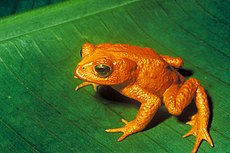
Back Funksionele uitsterwing Afrikaans Extinción funcional Spanish انقراض عملی Persian Extinction fonctionnelle French Kepunahan fungsional ID Funksjonelt utdødd NB Extinção funcional Portuguese Tuyệt chủng về chức năng Vietnamese 功能性滅絕 Chinese
| Conservation status | |
|---|---|
 | |
| Extinct | |
| Threatened | |
| Lower Risk | |
Other categories | |
| (list) | |
Related topics | |
 Comparison of Red List classes above and NatureServe status below  | |
Functional extinction is the extinction of a species or other taxon such that:
- It disappears from the fossil record, or historic reports of its existence cease;[1]
- The reduced population no longer plays a significant role in ecosystem function;[2][3][4]
- The population is no longer viable. There are no individuals able to reproduce, or the small population of breeding individuals will not be able to sustain itself due to inbreeding depression and genetic drift, which leads to a loss of fitness.[5]
In plant populations, self-incompatibility mechanisms may cause related plant specimens to be incompatible, which may lead to functional extinction if an entire population becomes self-incompatible. This does not occur in larger populations.
In polygynous populations, where only a few males leave offspring, there is a much smaller reproducing population than if all viable males were considered. Furthermore, the successful males act as a genetic bottleneck, leading to more rapid genetic drift or inbreeding problems in small populations.[6][7]
- ^ Extinctions in Near Time: Causes, Contexts, and Consequences 1999. Edited by R.D.E. MacPhee, Hans-Dieter Sues. page 202.
- ^ "What is the link between biodiversity and ecosystem services?". Scientific Facts on Biodiversity. Archived from the original on 2006-09-30. Retrieved 2006-12-16.
- ^ Säterberg, Torbjörn; Sellman, Stefan; Ebenman, Bo (2013-07-25). "High frequency of functional extinctions in ecological networks". Nature. 499 (7459): 468–470. Bibcode:2013Natur.499..468S. doi:10.1038/nature12277. PMID 23831648.
- ^ Yoshida, Kate Shaw (2013-07-12). "Not yet gone, but effectively extinct". arstechnica. Retrieved 2019-05-19.
But there is another type, called "functional extinction," which takes a more ecological approach. Some scientists argue that the threshold for extinction should not be the complete disappearance of a species, but instead the point at which there aren't enough individuals left in that species to perform whatever roles it was playing in the ecosystem.
- ^ Novak, Ben Jacob (2018-11-13). "De-Extinction". Genes. 9 (11). 548. doi:10.3390/genes9110548. PMC 6265789. PMID 30428542.
- ^ Pérez-González, Javier; Costa, Vânia; Santos, Pedro; Slate, Jon; Carranza, Juan; Fernández-Llario, Pedro; Zsolnai, Attila; Monteiro, Nuno M.; Anton, István; Buzgó, József; Varga, Gyula; Beja-Pereira, Albano (2014-12-26). "Males and Females Contribute Unequally to Offspring Genetic Diversity in the Polygynandrous Mating System of Wild Boar". PLOS ONE. 9 (12). e115394. Bibcode:2014PLoSO...9k5394P. doi:10.1371/journal.pone.0115394. PMC 4277350. PMID 25541986.
- ^ Pérez-González, J; Mateos, C; Carranza, J (2009-04-01). "Polygyny can increase rather than decrease genetic diversity contributed by males relative to females: evidence from red deer". Molecular Ecology. 18 (8): 1591–1600. Bibcode:2009MolEc..18.1591P. doi:10.1111/j.1365-294X.2009.04150.x. PMID 19302345. S2CID 24049683.
© MMXXIII Rich X Search. We shall prevail. All rights reserved. Rich X Search